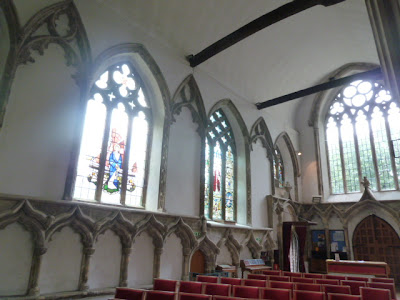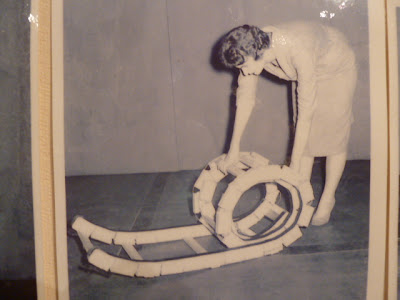It seems that there there is nobody around any longer to take the money for the pontoon. As part of Maldon District Council's cuts, the Council offered the local bailiff's deputy redundancy. They served him his notice, then realised he was near retirement age anyway, so asked if he would return his redundancy letter. Unsurprisingly, he declined. He therefore got his pension and his redundancy pay.The one key to the toilets/showers is now held by a lady who plaits braid to make bracelets on the quay.
Just above the quay is the church of St.Mary the Virgin Maldon. It has an imposing presence behind the Jolly Sailor, which sounds a little suspect, so needs explaining with a photo.
The interesting things about the church for me are the wide assortment of materials that have been used in building its walls at different times and the modern stained glass window. This was installed in 1991 to mark the millennium of the battle of Maldon.
The battle of Maldon was fought between the Saxons and the Vikings in 991 ( about 350 years after the ship burial at Sutton Hoo) .It would probably have been lost in history, but for the long poem written by an unknown Scop (poet) at the time.It records the death of Byrhtnoth, an ealdorman who had been sort of leader of the Saxons in view of the weakness of King Aethelred (The Unready). The Vikings had been doing what they were famous for, up and down the East coast and when they came up the Panta ( Blackwater) and landed on Northey Island, the Saxons decided enough was enough and it was time for a showdown and to face them properly.
A statue of him stands next to the door of All Saints Church.
The church is famous for being the only one in England and, it is thought western Europe, with a triangular tower.There are theories, but no sound answer to the question of why it has 3 sides.On top of the tower is a hexagonal spire, with three smaller spires.Towards the top of the spire is a canopy housing a "Sanctus bell", which was rung at the words "Holy, Holy, Holy" during the mass so that people outside knew what stage had been reached.
It's a church that has been much altered over the centuries. Inside it has an open plan character, due to early removal of one set of columns. There is a distinct difference between the ornate older part of the church and the plain 1800s addition.
Overall, what interested me most, was the stained glass, with the maritime themes,featuring the local barges and the intricate details within them.
Maldon also has some good non-ecclesiastical buildings
There was some good new- build stuff.
I also liked this example of where a dull semi had been converted into something more interesting with a bit of local clap board architectural styling.

In a gallery, I was surprised to see that an artist had been inspired to base an etching on wind turbines. Though, whilst passing these things, I had thought that when you see several in line they look like the Indian goddess Shiva.
A famous character in the town was Edward Bright, who had a bit of a weight problem before obesity had been invented.
In the museum in the park, a section spoke of the successes of local companies.I failed to see the point of the folding ladder. Why would anybody want to roll one up to something of this size?
I did see the point of the rescue life raft, that was dropped for 2nd World War aircraft crews that had had to ditch, but how do pilots become sailors?




























No comments:
Post a Comment